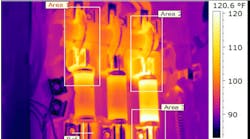At one time, it was common in many production facilities for the typical maintenance electrician to walk the floor with just a screwdriver and adjustable pliers in his back pocket. That transitioned to walking around with a tool pouch that had several screwdrivers and two sizes of adjustable pliers.
Things have advanced from there, including the carrying of an industrial DMM. But in your facility, have things advanced in the right direction? Or far enough?
You can get a head start by ensuring your tool pouch has the items you are most likely to need. Here’s an example for a maintenance electrician in a “typical” production plant:
- Basic hand tools (multipurpose screwdriver, commonly used standard wrenches, adjustable wrench, commonly used Allen screw wrenches).
- Various pliers (e.g., needle nose pliers, lineman’s pliers, pump pliers).
- Wire strippers.
- Spare test leads for your DMM.
- Roll of 600V tape.
- Roll of motor lead tape.
- Flashlight.
- Two locks and tags.
- The two smallish items that you most often have to walk back to the shop to get.
And what about the maintenance cart? If you’re doing preventive/predictive maintenance in the tool pouch and DMM mode, you’re no doubt making many unnecessary trips to and from the shop. It’s even worse if you are responding to downtime calls. Equip a cart so it covers the basic needs of both.
Here are suggestions for what a maintenance cart should have on board:
- Additional hand tools, such as a ratchet set.
- Shop rags.
- Portable light (larger than flashlight).
- Tachometer.
- Rotation tester.
- Infrared spot temperature gun.
- Four lockout hasps.
- Box of lockout tags.
- Calibration stickers.
- Plain label stickers.
- Box of ink pens (seriously, you don’t want to make a round trip to the shop for a pen!) and/or felt marker pens.
- Permanent marker.
- Insulating blanket.
- Box of nitrile gloves (do not use as electrical insulating gloves).
- Tube of gasket material.
- Boxes of solderless connectors (one box for each of the commonly used sizes).
The above lists may not work for your exact situation. They can serve as good starting points. Take the time to customize them so you aren’t making wasted trips. One way to determine if you’re carrying the right tools and supplies is by tracking how many trips you make back to the shop and which tools and supplies you had to get on each one.
If you pay attention to these basics, you will be more efficient and feel less pressured as you perform your various tasks. You also will end your day having walked fewer miles on concrete floors. Use that extra energy to do something you enjoy, but are often too tired to do, such as playing ball with the kids.





